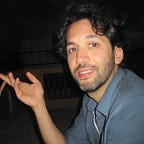Hollywood’s first interracial couple?
The Cuban-American influence on Latino identity and politics in the United States.
To accept one’s past — one’s history — is not the same thing as drowning in it; it is learning how to use it. ~ James Baldwin
Cuban-Americans have been the ‘model minorities’ of the Latinx community. We are the palatable archetype of a ‘Latino’ rooted in our race, socioeconomic status, and political world view.
Remember this guy? The guy from I Love Lucy? He was Desi Arnaz, also known as Desiderio Alberto Arnaz y de Acha III… a Cuban name for sure. He was from Oriente. Specifically, in Santiago de Cuba where the July 26th Movement, later known as the Cuban Revolution, started.
Desi a.k.a. Ricky Ricardo was the first mainstream image of a Cuban and of a Latino, expressing and living in his latinidad. His ‘schtick’ (because I’m a NYC Cuban), was that Lucy would do something funny, Ricky’s ‘hot latin temper’ would get triggered and he’d go on a loud tirade in his fast Cuban Spanish. Lucy, Ethel, and Fred would, of course look at each other, clueless at what was being said. Cue the studio audience laughter… and our laughter.
The show launched in 1951, well before the Cuban Revolution. A time where there was a considerable amount of cultural exchange between the US and Cuba. Some of the most pivotal musical advancements took place between NYC Jazz greats and Black Cuban musicians. In addition, educators, poets, scientists and doctors were exchanging their respective crafts. But due to white supremacy they were kept out of the mainstream image of Cuban-Americans, despite exceptional global icons like Beny Moré and Celia Cruz.
Yet, as progressive as I Love Lucy was trying to be, it struggled to navigate Desi’s white Cuban identity against the backdrop of the white US mainstream. ‘Desi’ or ‘Ricky’ was not named in the title of the show. Our beloved protagonist’s fictional full name, since RICKY=RICARDO would be… ‘Ricardo Ricardo’. Almost as though more than one Spanish name would have been too much for the audience to digest.
Meanwhile, Hollywood dubs the sitcom as showing the first mainstream ‘interracial couple’. Yes…interracial.
It says something about who and what was considered ‘white’ at the time. Desi was not white… at least not in the American mainstream in 1951, like the Italian-American and Irish-American immigrants who came before.
Meanwhile in Cuba, Desi was blanco.
And being white in Cuba brought with it many of the same white privileges experienced by US whites — safety, access, opportunity, and power.
Negros, mulattos y morenos were not permitted into segregated spaces… unless they were there to entertain, just like in the US. For example, ‘Barbaro del Ritmo’ himself, Cuban icon Beny Moré could perform in high class social clubs while the Dictator-President Fulgencio Batista, could not. His brown skin and non-european features were too offensive for the white sensibility of Cuba’s pre-revolution noble class.
But despite Desi’s blanco status, he needed Lucy by his side to legitimize him, to sign-off on the idea that he was safe. This is a white woman’s power to determine which men are acceptable and which are dangerous.
Four years after the launch of the show, in 1955, Emmett Till, a 14-year-old black boy was murdered by lynching for allegedly harrassing a white woman. Years later, his accuser admitted that she lied about Emmett’s alleged assault. If there were a spectrum of ‘the threat to white women, it became clear that white Cuban men, were a safe ‘other’ for the US white mainstream sensibilities.
Fast-forward a few years to 1959 and the first wave of Cubans left the island after the Cuban revolutionary government began public executions of counter-revolutionaries, seizing property and threatened to dismantle the institution of the family. These were the Cubans who had material wealth and / or upward mobility. Generally-speaking, these were white Cubans of varying class distinctions.
This new community of exiles were white refugees who skirted the typical American immigration experience first through the Cuban Adjustment Act of 1966 that was enhanced 30 years later through the wet foot / dry foot policy. It saw these white Cuban immigrants of no threat to the American status quo and conveniently served an ulterior purpose to undermine the new Cuban government and indirectly jab at Communist USSR.
This era was the birth of the US grappling with the idea of how to categorize Latin-American blancos and more specifically Cuban blancos against the US backdrop. We ended up with this spicy-white-latinx-archetype that was a fraternal twin to US white-body archetype. Which makes sense since the two have run parallel for centuries in their theft of indigenous land and enslavement and genocide of African and Indigenous people.
